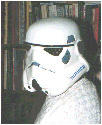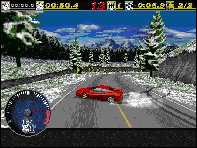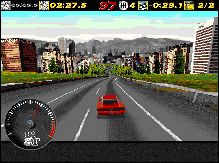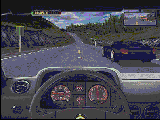

 A Review by Alan Tebb
A Review by Alan Tebb
ďI feel the needÖthe need for speedĒ
And with these immortal words from Top Gun, Tom Cruise leaps into his F-14 Tomcat fighter and roars off to punch holes in the sound barrier.
Well, I canít say Iíve ever flown in a jet fighter, but every day I dogfight with other Canberra drivers on the highways and byways of our fair city. You know what itís like Ė speed limits, stop lights, radar traps and errant lane changers. I donít know about you, but my trusty steed is a clapped out red van that is 14 years old and belches clouds of black smoke (maybe youíve seen me?). So what would you give to drive a Chevrolet Corvette ZR-1 (drool), or maybe a Porsche 911 Carrera (pant-pant), or how about a Ferrari 512TR (ooooh Iím smokiní), or perhaps Ė wait for it Ė a shiny, bright red Lamborghini Diablo VT (aaaargh, Öthat felt good).
Well, now you can. Through the brilliant partnership of Electronic Arts and Road & Track magazine, you can get behind the wheel of any one of these four supercars and put the pedal to the metal.
The last computer driving game I bought was Test Drive II from Accolade, but donít ask me how many years ago that was. The Test Drive games were humble beginnings, very arcade style in their approach and not at all convincing in terms of their ability to simulate the characteristics of different cars.
This is where The Need for Speed stands out from the rest and itís my view that the difference is in the strategic partnership between a computer games company, that knows about computers, and a car enthusiastís magazine, that knows and loves cars. From the moment this CD begins, you can tell that this is a product made by people who idolise exotic machinery. I am by no means a rev head and I never will be, but this game had me visually gob smacked from start to finish.
Just to get you in the mood, The Need for Speed lets you start by playing one of the videos on each of the eight cars that feature in the simulation. Each clip is a professionally filmed and choreographed showcase of what can only be described as motor car magnificence in motion. As well as the video, each carís general statistics, mechanical details and develop- ment history is there to read. The detail is not exhaustive, but there is enough to give the average player the information needed to make their driving experience that little bit more interesting.
When your personal need for speed gets to the point where you can wait no longer, itís time to pick a car, pick a place and select a game play mode from the main menu screen. In addition to the four cars I mentioned previously, you can also get behind the wheel of a Mazda RX-7, Acura NSX, Dodge Viper RT/10 or a Toyota Supra Turbo. The environmental options include three open road rides through alpine, coastal or city landscapes, or three circuits at Rusty Springs (desert), Autumn valley (forest) or Vertigo Ridge (mountains).
The detail in each car has been lovingly recreated. Except for the fact that the steering wheel is on the left hand side and the gear stick on the right, the dash, controls and general layout are just like the real McCoy.

Visuals are one thing, but we all know that what gets the juices running is the throbbing vibration of hundreds of horses trapped under the bonnet. Other than jumping up and down in your chair, there isnít much that can be done to recreate the physical motion, so the game designers have gone to a lot of trouble to produce a sound track that aurally fools you into thinking there are hundreds of horses trapped under the bonnet.
If you have tiny little side speakers sitting like two boof-ears off your monitor, then Iím sorry Ė it just wonít cut the mustard. For this experience, nothing but full blown stereo speakers through some hearty amplifier circuits will do. And what a sound it is! Engine revs match accelerator motion, tires squeal and crashes are gut wrenching. According to the box, the sound of each car engine has been recorded from sound tests performed in each vehicle, in order to give the automotive purists their total car experience.

The box also says (and I have to take their word on this) that the physics model for each carís motion also accurately recreates acceleration, body roll and lateral-g forces. I decided to test this out by driving different cars on the same closed circuit track, at the same speed of 180 km/hr. Sure enough, I could roar through certain curves in a Lamborghini, where the Dodge Viper would put me into the crash barrier every time.
I also spent hours doing handbrake skids and countless 360s making perfect figure eights, without once bothering the neighbours, going back to Discount Tyres for new rubber or being arrested for larrikin behaviour. The Need for Speed is so well designed, it will even let you spin the car 180 degrees and drive the wrong way around the race circuit if you really want to.
Customising driving options is easy with a choice of either automatic or manual gear changes, turning on the Anti-Lock Braking System if the car is normally fitted for ABS and again, if the car is fitted, you can select traction control to prevent wheel spin.
For the true racing competitor, you have the game play choices of driving against the stopwatch in timed speed trials, racing head to head against a computer opponent (in a car you choose, so there is a chance to nobble the computer) or against another human driver by using the modem game play options. In single race mode you can drive against seven computer-generated opponents or six computer opponents and one modem opponent. The other option is tournament mode, where you must place first in all races to gain access to a bonus track (which is not otherwise described in the manual). Tournament mode has three classes: A, B and C. Each class includes cars of similar performance types to create a relatively even playing field.
Perhaps the piŤce de resistance in The Need for Speed is the graphics. I am amazed, for example, that on the race track circuits, tyre marks left from fast starts and sudden stops are there on the road surface for the duration of the game. As lap after lap passes by, the tyre marks stay to remind you of earlier mishaps. Handbrake skids or 360s produce clouds of white smoke billowing off burning tyres. And last but not least, the speedway graphics are absolutely amazing. The cityscape of high rise buildings, road signs and highway overpasses flashes by as you race at 200 km/hr through the traffic.

Users with a slow 486 will miss out because, on loading, the game wants to default to the lesser graphics resolution of 320x200, which, to be honest, is like an old VGA game. On a fast 486 (120Mhz) you can manually change the graphics to the higher 640x480 resolution in a full screen, turn on the far distance detail, change the car detail to high and set the image quality to high without losing smoothness in the game play.
For the ultimate driving experience there is only one enhancement left to make. Forget the silly keyboard options, throw away the joystick: after all, how can you drive a Ferrari using the numeric keypad? Clear the desk and make way for the Thrustmaster Formula T2 steering wheel gear stick and pedal box.
This amazing game accessory costs a mere $290 and comes with a life size hotrodderís padded steering wheel and a heavy, plastic and metal pedal box with two reasonable sized pedals, one acting as the brake and the other as the accelerator. Combined with The Need for Speed software and the right hardware, I can guarantee you a simulated driving experience that gets close to the Time Zone driving machines at the mall. A special thanks to the crew at BitStorm for lending me the Thrustmaster to trial over the weekend. It was a long face on Sunday night that had to pack away the T2 for return the next day.
I havenít been this excited about a game in a long time. If only I could rig up an atomiser to blow petrol and burning rubber fumes into my face, I would happily play The Need for Speed until someone came to pry my fingers off the T2 steering wheel. Combine the cars, the driving, the sound and the graphics, and I think The Need for Speed at $79 is a great addition to any enthusiastís computer games library.
SUMMARY
Title: The Need for Speed
Format: 1 x CD-ROM
Manufacturer: Electronic Arts
Genre: Simulation/Driving
Price: RRP $89.95.
Classification
Suitable for 6 years and over.
System Requirements
The Need for Speed requires as a
minimum a 486DX2-66 Mhz for
320x200graphics resolution (yuk!) or the
equivalent to a Pentium 90 with PCI
video for 640x480 graphics resolution
(yes!!), 8 Mb of RAM, 256 VESA
compatible video card with 512 K
memory, 4Mb hard disk space, double
speed CD-Rom, sound card, joystick or a
Thrustmaster Steering Wheel.
Assessment
(Out of a possible 



 maximum)
maximum)
Graphics:
(320x200) 

(640x480) 



At the higher resolution The Need for
Speed is a joy to the eyes. Terrain detail,
car detail and multiple viewing angles
from within the car, behind the car or
from the helicopter race-cam makes the
simulation highly effective. Graphic
delights include skid marks, clouds of
burning rubber and magnificent video
clips of each supercar going through its
paces.
Sound
Sound Effects 




The music and voiceover commentaries
are okay but the car sound effects are
brilliant. Some of you may have heard
about the NuReality sound technology
that delivers 3D sound to computer
games. I achieve this effect by using specialised
hardware, but The Need for
Speed comes with this technical enhancement
built in. Try playing the game
through a set of headphones with this
feature enabled. You can hear cars passing
you on your left or right as you race
against them.
Game Play 




Single race mode against several
computer generated opponents, a modem
opponent or a mix of both is a real buzz.
Adding the Thrustmaster T2 driving set to
this game really has to be experienced to
be believed.
Addictiveness 




The only thing that could stop me
from playing this game was the need for
the inevitable pit stop Ė of the natural
kind. I have not had this much fun playing
a computer game in a long time.
Violence
None to speak of. It is possible to
deliberately cause spectacular car accidents
by ramming your $250,000 Lamborghini
Diablo into the side of a competitor
and watching them get airborne,
finishing upside down and smokiní on the
racetrack. And letís face it, in a virtual
world, why wouldnít you?
Documentation 


Adequate to the task but nothing
flash.
Ease of Installation 

The game is designed for play with
Windows 95 or DOS. I tried the Windows
installation and gave up in disgust,
preferring the DOS installation instead. I
have to say that the setup of this game is
not as user friendly as most games on the
market at the moment and I had a lot of
trouble getting my sound to work. Very
rarely do I need expert advice, but on this
occasion, I had to call on BitStorm for
assistance.
Value for Money 




Well, if you canít tell by this point, I
think The Need for Speed is one of the
best value for money packages Iíve seen
in a long time. If you have a personal
need for speed, drive slowly to BitStorm
and get yourself a copy of this CD.
For the month of August, BitStorm in
the Canberra Centre will sell The Need
for Speed to PCUG members on
presentation of a current membership
card for $79.95.
LATE NEWS BREAK -- By the time you read this review, BitStorm will have taken delivery of a newly upgraded version of The Need For Speed. In addition to the modem game play, the new version features eight player network connectivity so that several people can race against each other and for those of us that are forced to drive with a joystick or use the keyboard, the game has improved steering and handling. An extra two tracks are included, but I have no details about the track types or location. Last but not least, the new version features 12 CD music soundtracks so that you can imagine yourself driving a hot car with the stereo turned up full volume as well. BitStorm will stick to the $79.95 price for the new version for PCUG members carrying a current membership card.
Any comments or queries about this game review or previous reviews featured in Sixteen Bits can be passed to Alan via Internet Email - atebb@pcug.org.au
 Back to July 1996 Index
Back to July 1996 Index